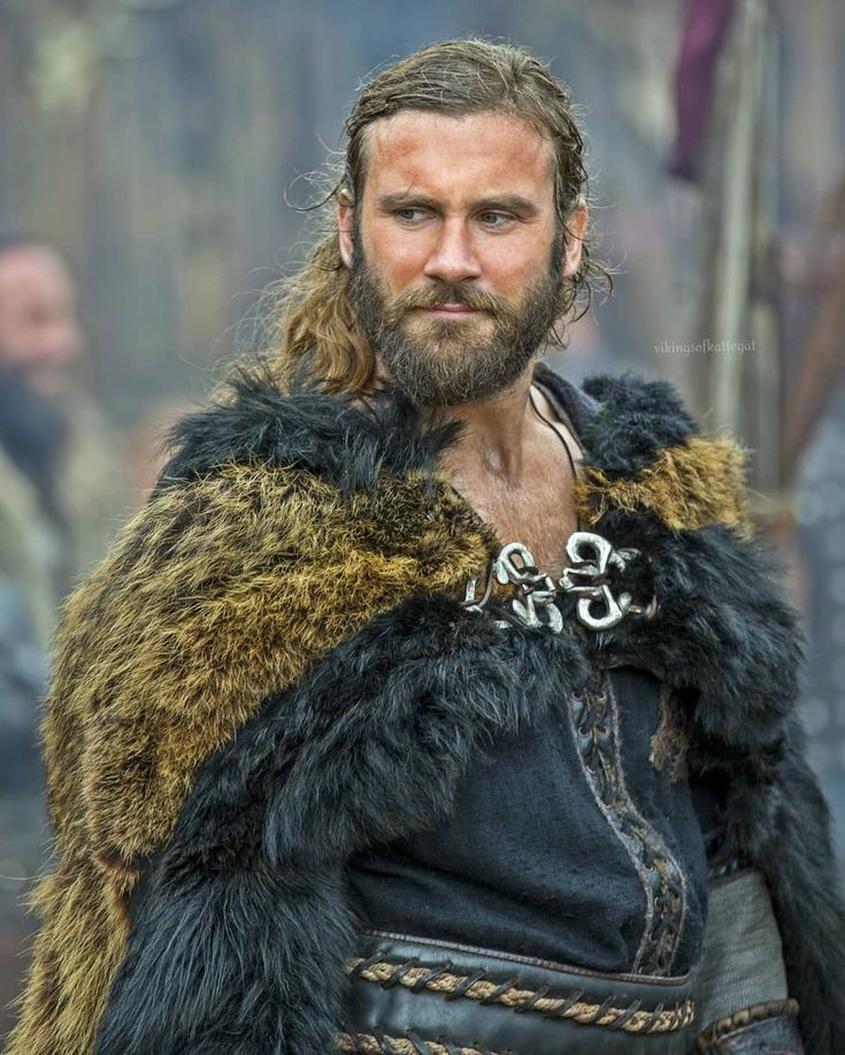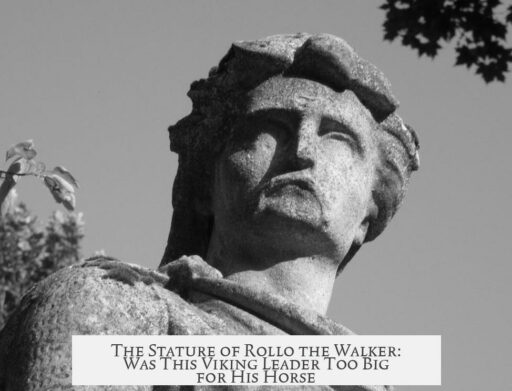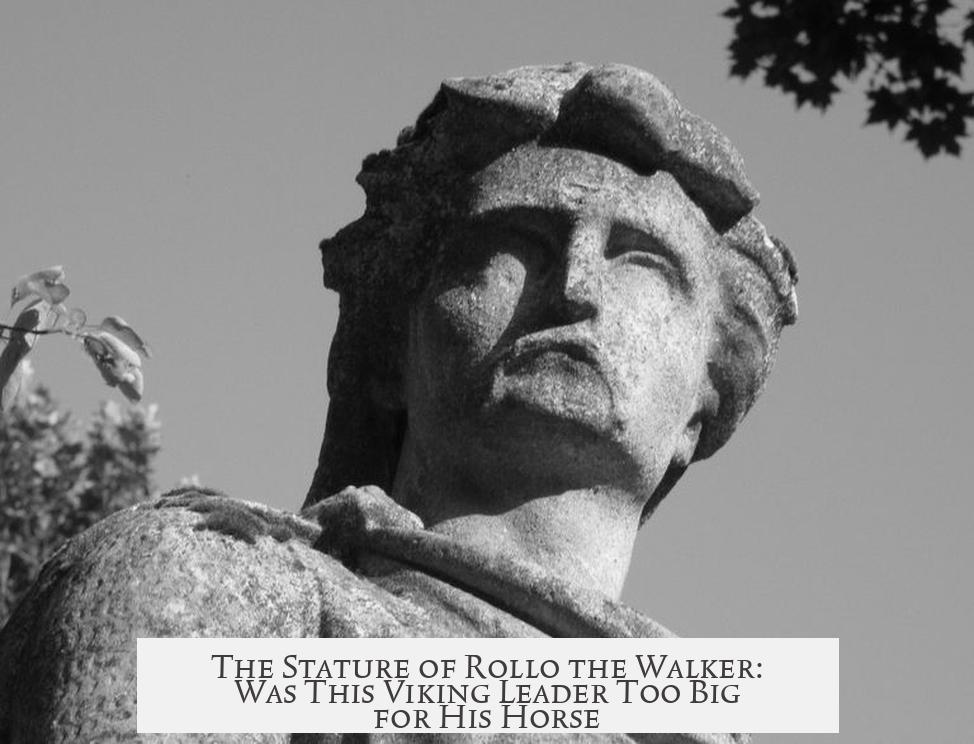Rollo the Walker (Göngu-Hrólfur) was said to be so large that he could not ride a horse, meaning his size exceeded what Viking-age horses could carry comfortably. Estimating his size requires comparing his stature with known figures and considering the physical limits of contemporary horses.
The saga texts describe Hrólfr, identified with Rollo, as a man of exceptional height and girth. A key passage from Göngu-Hrólfs saga states that he was “so heavy that no horse can bear him all the day,” causing him to travel on foot continuously. This is supported by the Latin source Historia Norvegie, which nicknames him Göngu-Hrólfr or “Rollo the Walker,” emphasizing that his great size prevented horse riding.
To understand how large Rollo must have been, it helps to compare him with King Haraldr harðráði of Norway, one of the tallest historical Norse figures. Harald’s height is recorded as “five ells,” which translates to approximately 230 centimeters (around 7 feet 7 inches). For context, the old Norse ell measures about 46 cm. These figures place Harald among the giants of his time, yet he reportedly rode horses without issue.
Since Harald could ride horses with his tall frame, Rollo must have been significantly bigger and heavier to warrant the claim that no horse could carry him. The story suggests Hrólfr’s weight and size would exceed Harald’s by a considerable margin, making horseback travel impractical.
Viking horses were small, durable breeds resembling the modern Icelandic horse. These horses averaged about 140 cm (4 feet 7 inches) in height and weighed roughly 350 kilograms. Modern research on Icelandic horses shows they can carry a rider weighing about 35% of their own body weight, roughly 120 kilograms, but only for short durations. This aligns with the horses used in Viking times, which were not suited for heavy or prolonged riders.
Considering this, a Viking rider weighing more than 120 kilograms would strain the horse, especially over a full day’s travel. Tall Viking leaders like Harald, around 210–230 cm tall, could ride such horses because their weight generally remained below or near this capacity.
Therefore, for Rollo (Göngu-Hrólfr) to be “too big to ride,” he likely exceeded around 230 centimeters in height and weighed substantially more than 120 kilograms, probably nearing or surpassing 150 kg. His bulk must have been extreme enough to overwhelm the endurance of typical Viking horses.
The saga’s narrative may also reflect exaggeration or legend-building, but it signals a real perception of Rollo’s extraordinary size. His epithet “the Walker” symbolically marks him as a giant among men, physically too massive for common transport means. This fact would also underline his strength and imposing presence in Norse memory.
| Aspect | Details / Estimates |
|---|---|
| Rollo’s Height (Hypothetical) | Greater than 230 cm (7 ft 7 in), likely 240+ cm |
| Rollo’s Weight (Estimated) | Likely above 120–150 kg, heavy build implied |
| Typical Viking Horse Height | Approx. 140 cm (4 ft 7 in) |
| Horse Carrying Capacity | Max ~35% of horse weight (~120 kg) for short periods |
In summary, Rollo the Walker’s large size was exceptional even among Norse giants. Considering that Viking horses were small and could only carry about 120 kilograms comfortably, his stature needed to surpass that threshold by a significant margin. This physical limitation gave rise to his nickname and influenced saga traditions portraying his dominance on foot rather than horseback.
- Rollo was likely taller and heavier than King Haraldr (~230 cm).
- Viking horses around 140 cm tall could bear riders up to ~120 kg briefly.
- Göngu-Hrólfr’s size exceeded these limits, preventing horseback travel.
- His epithet signifies an extraordinary physical presence in saga tradition.
How Large Was Rollo the Walker? Unpacking the Viking Leader’s Monumental Stature Against His Horse’s Hoofbeats

Rollo the Walker, also known as Göngu-Hrólfur, earned his nickname because he was supposedly too large to ride a horse for an entire day, forcing him to traverse on foot. But just how immense was this Viking leader in real terms? To understand, we need to explore Viking-age horse sizes, compare Rollo’s size to known historical giants like King Haraldr harðráði, and examine saga accounts alongside scientific research on equine load capacity.
This post becomes a fascinating patchwork of history, legend, and biomechanics combined. Let’s saddle up and get going.
A Viking Too Big for the Saddle? The Saga and Historical Texts Say Yes
The saga Göngu-Hrólfs saga vividly describes Hrólfr son of Sturlaug as a man “very distinguished both in his girth and height,” so heavy that “no horse can bear him all the day,” insisting that he “always [travelled] on foot.” That’s not a subtle way of saying he was a big guy — it’s a full-blown proclamation of Viking-sized bulk.
In fact, the saga’s author does not merely jest. According to Historia Norvegie, a 12th-century Latin source, comrades gave Hrólfr the moniker “Göngu-Hrólfr” precisely because his “immense size made it impossible for him to ride.” This text, the oldest known linking the name to the historical Rollo of Normandy, underscores the extraordinary impression this Viking’s physicality made on his peers.
The question then becomes: How tall and heavy would one have to be to actually deserve such a nickname in an era when horseback travel was a necessity for leaders and warriors alike?
Measuring Giants: Was Rollo Really Taller and Heavier Than Harald Hardrada?
Historical records offer clues about the typical height of notable Vikings. King Haraldr harðráði, Norway’s renowned 11th-century warrior king, is recorded in Haralds saga Sigurðarsonar as standing five ells tall. The Old Norse ell measures about 46 centimeters (18 inches). So, five ells translates roughly to 230 centimeters, or about 7 feet 6 inches.
Hold your axes! Seven feet plus makes Haraldr quite a towering figure by medieval standards, akin to a modern basketball player. Another text hints at a height around 7 feet (213–231 cm depending on the exact foot length conversion). This height was considered extraordinary and was remarked upon in the sagas.
However, Haraldr could still manage to ride a horse with ease — his height, though extreme, did not incapacitate his mobility. Which leads to the intriguing idea that, to be truly “too large to ride,” Göngu-Hrólfr needed to exceed even this impressive stature and weight substantially.
So, it’s reasonable to infer that Rollo had to be over 230 cm tall (7 feet 6 inches), a height that would definitely tax any horse carrying him for any prolonged duration.
The Viking Horse: Small Size, Big Load?
Now, let’s talk horses. The Vikings didn’t have broad-chested, racehorse-sized steeds like those used in later medieval jousts. Their horses resembled the modern Icelandic horse — small, hardy, and compact.
According to modern studies, the Icelandic horse stands about 140 cm (around 4 feet 7 inches) at the withers and weighs roughly 350 kilograms (770 pounds). Research focused on these horses’ physiological response to loads revealed they can comfortably carry 35% of their own body weight — that’s about 120 kg (265 pounds) — but only for short durations. For longer rides, lighter loads are advisable to prevent strain.
Given this, it’s safe to conclude that typical Viking-age horses had physical limits that would struggle to carry a very heavy rider all day. While a tall but slim rider could ride such a horse, a very tall and bulky individual would exceed the horse’s tolerance.
Putting It All Together: How Large Was Göngu-Hrólfr, Really?

If we combine all pieces of evidence, the image of Göngu-Hrólfr sharpens:
- His height and weight had to surpass King Haraldr harðráði’s approx. 230 cm (7’6”) stature and accompanying body mass.
- He must have exceeded 120 kg substantially to be termed “too heavy for all-day riding.” Vikings rode Icelandic horse-like animals whose endurance stops near that weight threshold.
- These horses’ limited size (approx 140 cm tall) means a rider taller than 230 cm with considerable bulk probably tipped the scales past what was manageable on horseback.
In practical terms, Rollo might have been around 7 feet 8 inches, or even pushing 8 feet tall with a weight exceeding 130–140 kg (roughly 290–310 pounds), given that the word “heavy” in the saga indicates more than height alone—it includes girth and mass. His presence would have been positively towering and impressively massive, especially in a culture that prized physical prowess.
Why Does It Matter? Actually, It Makes History More Human—and Humorous
Why should we care about how big a Viking chieftain was? Because this gives color and grit to the legends, and challenges our imaginations to rethink Viking age life. Rather than stiff statuesque heroes, their leaders sometimes had real, physical quirks—like being too large to ride horses comfortably.
Imagine the mightiest Viking scene: the leader leads on the ground, marching rhythmically beside his warband, giant in stature, because his trusted steed can only carry smaller men who leap onto saddles with ease.
Also, it reveals how practical details filtered into the oral traditions and sagas, preserving a kernel of truth beyond myth. The nickname “Göngu-Hrólfr” wasn’t just a joke; it was a lasting reminder of his sheer size.
Practical Historical Tips: How to Weigh Yourself in Viking Terms
Next time you wonder about your size in Norse terms, measure yourself in ells. If you’re over 2.3 meters, congratulations—you’re Viking-giant material! And if you weigh more than 120 kilograms, remember: you might find horses a bit weak to support your Viking adventures.
Of course, humor aside, this also shows how equine companions shaped Viking mobility and military command. Leaders like Harald could rely on horseback, but Göngu-Hrólfr was a walker out of necessity.
In Conclusion: Bigger Than the Myth, Larger Than Life
Rollo the Walker’s nickname clearly reflects his gigantic stature, likely well beyond 230 cm in height, with such bulk that would have been extraordinary even by Viking standards. Considering the size and capacity of the Viking horse, his size would have exceeded what a horse could comfortably bear for any significant duration.
This intersection of saga lore, historical measurements, and equine science crafts an intriguing portrait of a man who literally walked his way through legend because he was too big to ride.
Next time you read Viking sagas or hear about great leaders, remember: some of those tall tales have a literal basis in remarkable feats of human size. And sometimes, being called “the Walker” means you’re just too huge for the horse to handle!
References & Further Reading
- Göngu-Hrólfrs saga
- Kunin, Devra (2001), A History of Norway and The Passion and Miracles of the Blessed Óláfr
- Snorri Sturluson, Heimskringla, Finlay & Faulkes trans. 2015
- Icelandic Horses Carry Heavy Burdens Research (2015)
How tall would Rollo the Walker (Göngu-Hrólfur) have been to be unable to ride a Viking horse?
He was likely over 230 cm (7 ft 7 in) tall. This exceeds the height of King Haraldr harðráði, who was said to be about 210–230 cm and could ride horses of that era.
Why couldn’t Göngu-Hrólfur ride horses that were used by Vikings?
Viking-age horses, similar to modern Icelandic horses, were around 140 cm tall and could carry riders up to about 120 kg, but likely only for short periods. Göngu-Hrólfur’s size and weight surpassed these limits, forcing him to travel on foot.
What was the typical size and capacity of Viking horses relevant to Göngu-Hrólfur’s nickname?
These horses weighed about 350 kg and stood roughly 140 cm tall. They could carry riders up to 35% of their body weight (~120 kg). Someone heavier or taller would be difficult to carry all day.
Is there historical evidence that a Viking leader was too large to ride horses?
Yes. The saga *Göngu-Hrólfs saga* and *Historia Norvegie* both say Göngu-Hrólfur was so large he always traveled on foot. This suggests his size went beyond the capacity of available horses.
Could King Haraldr harðráði ride horses despite his great height?
Yes. Despite being very tall (around 210–230 cm), Haraldr is described riding horses. This shows that only someone even bigger than him would be unable to ride, like Göngu-Hrólfur.




